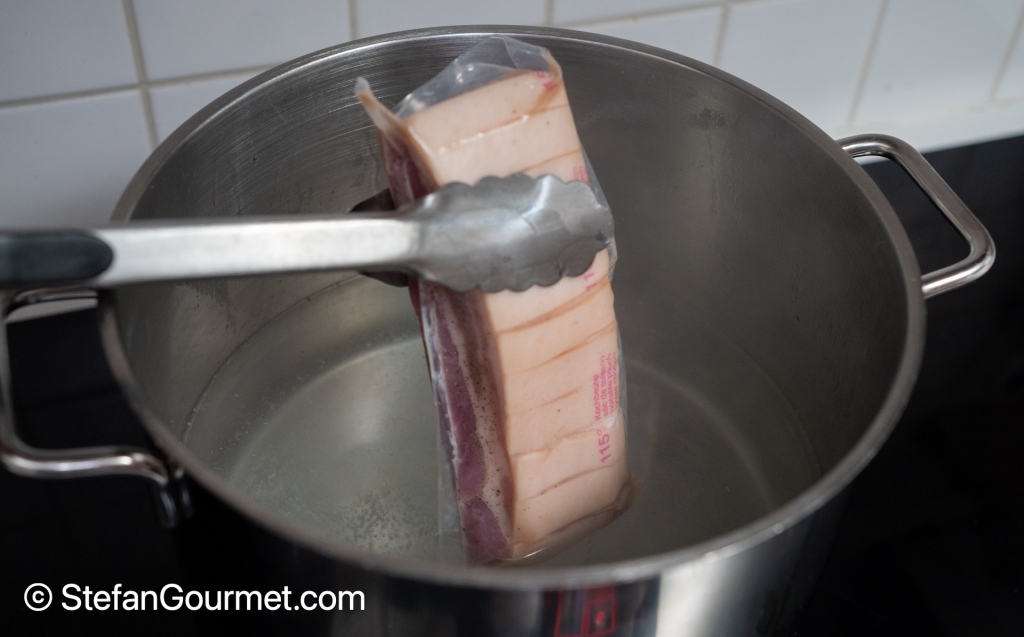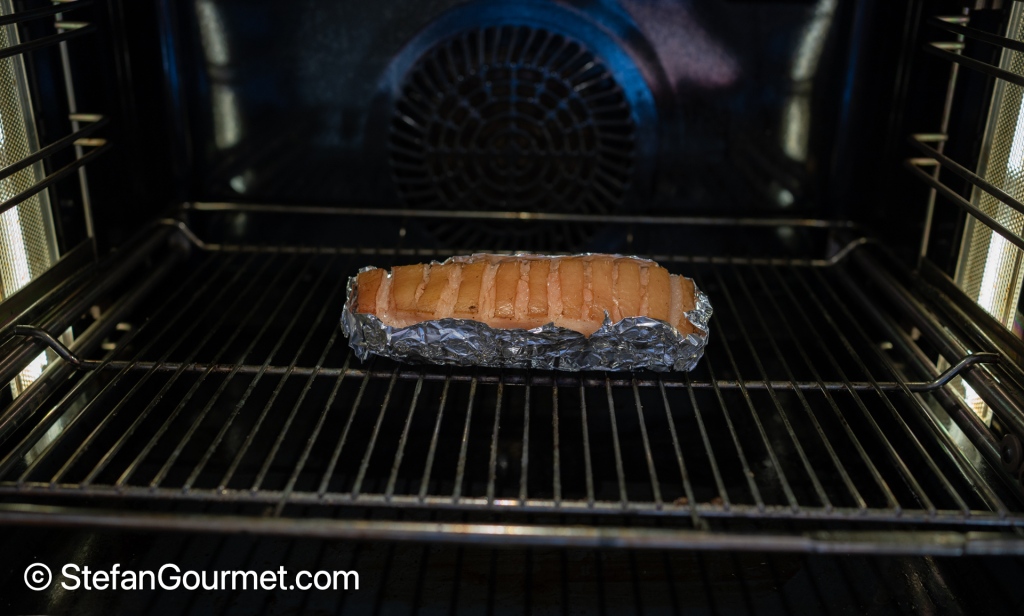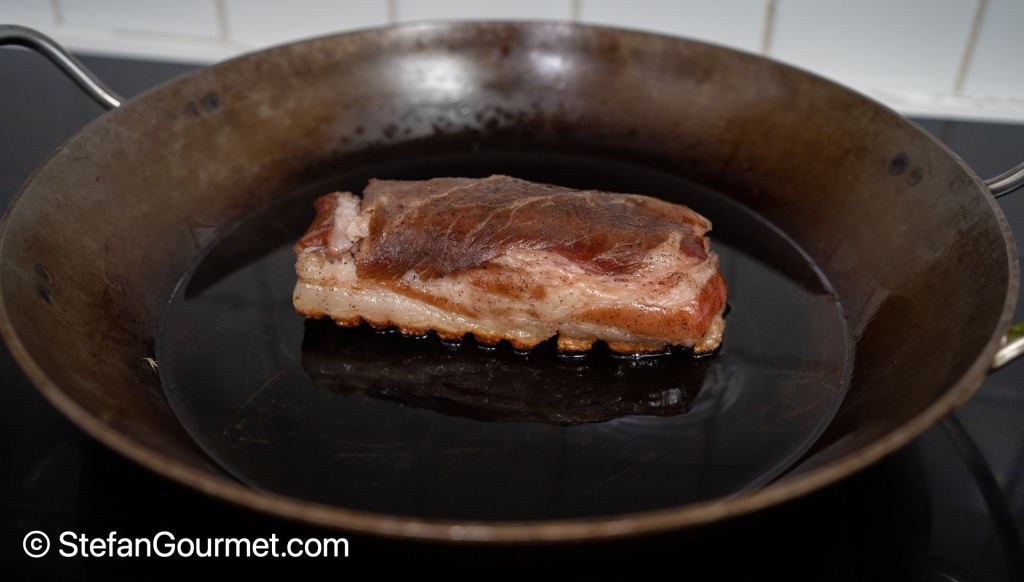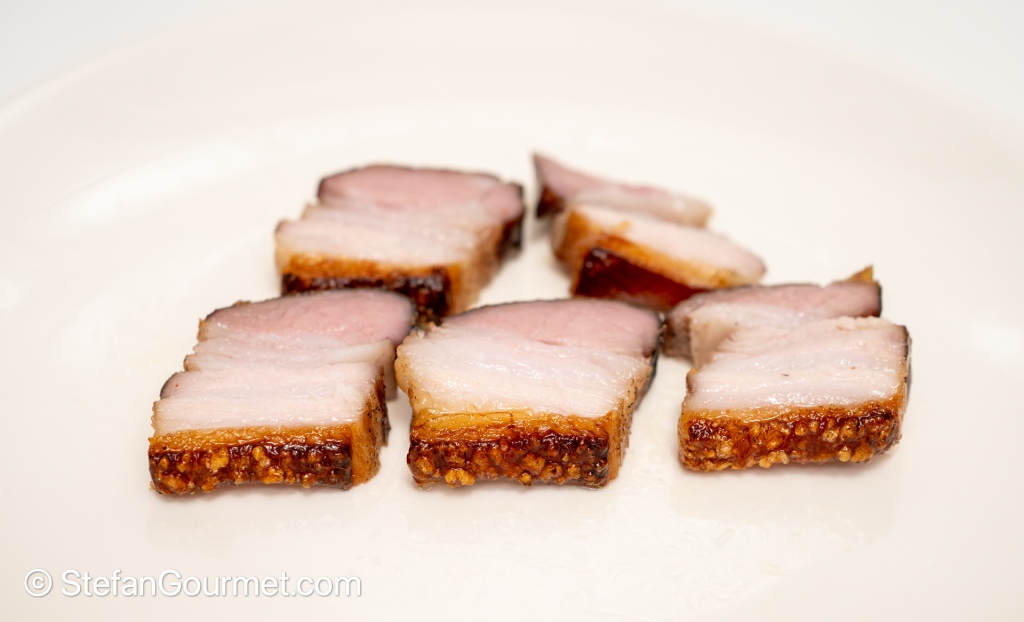
Sous vide pork belly is great, because the meat will be tender and unctuous. Sous vide belly with crispy skin is even greater, due to the contrast between the soft meat and the crispy skin. It is however not easy to get a crispy skin, as simply pan frying, grilling, or broiling is not going to do the trick and will result in tough leathery skin. In this article I explain a fool-proof method in seven steps to prepare sous vide pork belly with the crispiest skin you have ever tasted. Obviously, you will need a slab of pork belly with skin to prepare this.

The first step is to score the skin with a sharp knife. This will help with rendering the fat when finishing the skin, and it will also make it easier to slice the pork belly once it is finished. Make sure to cut through the skin and only slightly into the fat underneath, about 1 to 2 millimeters or 1/16″ deep.

The second step is to apply a dry rub. Many folks use a brine, which is additional work that doesn’t add any value. You could use just salt, but it is nice to include some brown sugar and freshly ground black pepper.

Make a simple dry rub by mixing salt, black pepper, and brown sugar in a small bowl. Use only part of the salt for this, as the skin side should be rubbed with salt only. De total amount of salt should be about 1.2% of the weight of the meat. So for 300 grams of pork belly you will need 3.6 grams of salt, approximately 1/2 teaspoon of table salt. If you add sugar, use about half of the amount of salt.

Apply the rub everywhere on the surface of the meat, except for the skin side. Use only salt on the skin side, making sure to rub the salt into the scores. Do not put sugar on the skin, because then the skin would burn when you finish it.

Vacuum seal the meat after you have applied the dry rub, and allow to rest for 8 to 24 hours in the refrigerator. This will allow the salt and sugar to penetrate into the meat before it is cooked.

The third step is to prevent a nasty smell that can occur when you cook sous vide at a temperature below 60C/140F for longer than about 8 hours. Scald the meat in hot water (at least 75C/170F or boiling) for 10 to 20 seconds. In this article I explain why this is necessary.

The fourth step is to cook the pork belly sous vide for 48 hours at 57C/135F.
At this temperature the meat will become tender, as the collagen is converted into gelatin. This happens very slowly at such a low temperature, which is why it takes 48 hours. At 57C/135F, the fat will not render out. If you want the fat to render out, you could opt for a higher cooking temperature, such as 24 hours at 74C/165F (no scalding in hot water needed then). The meat will become fork tender and it will be difficult to slice it nicely. In this article I compare various time and temperature combinations for pork belly.

After sous vide cooking, take the meat out of the bag, and pat it dry with kitchen paper (especially the skin side). Reserve the juices to make a sauce. You will notice that the juices do not contain fat (because fat would float on top), but do contain gelatin (as the juices will firm up as they cool to room temperature).

The fifth step is the most important step to obtain crispy skin, which is to allow the skin to dry. Wrap the meat side of the pork belly with aluminum foil, to prevent the meat from drying out. The skin side should be left bare. Allow the skin to dry in the oven at 65C/150F for at least 1 hour. It is best to use the “drying” setting if your oven has one, or to turn on the oven fan.
By allowing the meat to dry in the oven at 65C/150F, the core temperature of the meat will not increase beyond the 57C/135F at which the meat was cooked sous vide. That may seem illogical, but the drying process (evaporation) requires a lot of energy, which cools the meat.

The sixth step is to sear the skin on medium heat until it is crispy in a generous layer of oil (at least 2 millimeters or 1/12″, so allow at least 90 mL of oil in a round pan with a diameter of 24 centimeters, or at least 1/2 cup of oil for a pan with a diameter of 11″). Medium heat works better than high heat, because the skin would burn before it has a chance to become crispy over high heat. The generous layer of oil is required for good transfer of heat, not just to the skin but also through the scores into the fat behind the skin. Crisping up the skin takes some time; it can easily take 5 minutes for the skin to become golden brown and crispy. If the skin has not been dried sufficiently in the oven, droplets of water that are released into the hot fat will splatter violently. If that happens, the best thing to do is to return the pork belly to the oven for at least half an hour, to dry some more.

As soon as the skin is crispy and golden brown, turn to sear the meat side as well. 30 seconds to 1 minute will be sufficient. The ‘bubbles’ that you can see now on the skin are a sign that the crisping has succeeded.

The seventh and final step is to slice the pork belly nicely. This will be easy because of the scoring and the tenderness of the meat.

Serve the slices of pork belly on preheated plates, to prevent them from cooling off too quickly.
Flashback



Ho quello che serve per fare il sottovuoto! Ora devo solo decidermi 🙂
LikeLiked by 1 person
😍
LikeLike
Stefan,
Thanks again for yet another great guide! You’re relentless in perfecting cooking techniques is much appreciated. Say have you been able to get crackling on an Asian style (sous vide) pork belly? This is my nemesis. I love the char siu pork belly but the marinade contains large amounts of sugar and some soy sauce, making it burn very easily. I’ve tried many times, drying over night, salt cover, frying in oil, under the broiler you name it. Always burns… Granted I’ve never tried this method, but I don’t have an oven that goes as low as this (it’s gas, so minimum is 130°C and not very accurate). Be very curious to hear if you’ve succeeded with high sugar/soy sauce marinades this way!
LikeLike
I’ve not tried this myself, but this may work:
Chill the pork completely after sous vide cooking in the refrigerator.
Pat it dry thoroughly with paper towels.
Wrap in foil as in my post.
Put it in the at the lowest 130 with a core thermometer to monitor the core temperature.
Keep the oven door ajar to keep it dry inside.
If the core temperature rises to about 50C, turn off the oven but leave the meat in there to keep drying until you’ve reached at least one hour.
Now pan fry in plenty of oil over medium heat, not high heat to crisp up.
Let me know if this works. Good luck!
LikeLike
Thanks for the suggestion, I will give it a try and report back!
LikeLiked by 1 person
The process of drying can be achieved simply by exposing the skin in the fridge for a day or so…
LikeLike
That is correct, however then the pork belly would need to be heated to serving temperature, which would have to be done in an oven anyway because reheating sous vide after drying would soften the skin again. If you just sear it after drying in the fridge, it will be cold on the inside.
LikeLike
Hello Stefan.
I would not reheat sous vide. I would bring it to eating temp in a fan oven (say 55) and then finish it with the oil as per your instructions
LikeLike
Well then your reheating step is almost the same as my drying in the oven step, so you could skip the drying in the refrigerator part.
LikeLike
Good thinking! I’m one hour away from tasting. For practical reasons it has been 59C for 42 hours…
LikeLiked by 1 person
Pork belly is much too rich for me these days but your pork belly skin definitely looks wonderfully crispy and delicious, I just couldn’t eat a meal of it. I can certainly see how your skin crisping method might transfer to a duck breast or even whole chicken.
LikeLike
Duck breast is an interesting idea. A whole chicken would be more difficult as it is not flat, but the drying is of course an important step (think Peking duck). As for pork belly being too rich: I would recommend enjoying a small portion.
LikeLike